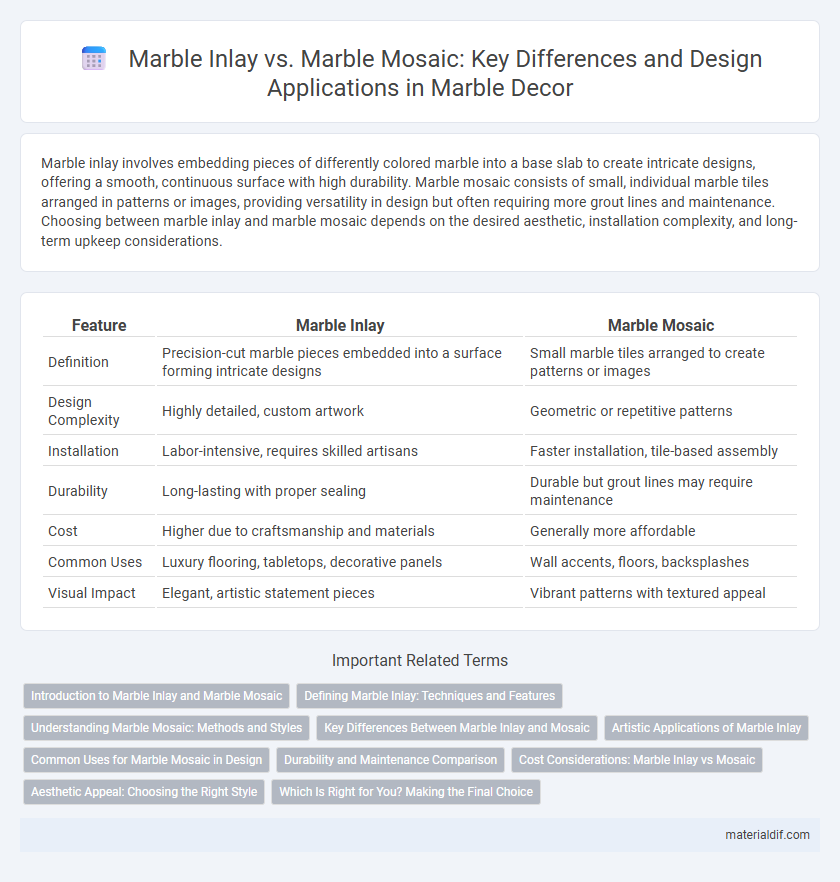Marble inlay involves embedding pieces of differently colored marble into a base slab to create intricate designs, offering a smooth, continuous surface with high durability. Marble mosaic consists of small, individual marble tiles arranged in patterns or images, providing versatility in design but often requiring more grout lines and maintenance. Choosing between marble inlay and marble mosaic depends on the desired aesthetic, installation complexity, and long-term upkeep considerations.
Table of Comparison
| Feature | Marble Inlay | Marble Mosaic |
|---|---|---|
| Definition | Precision-cut marble pieces embedded into a surface forming intricate designs | Small marble tiles arranged to create patterns or images |
| Design Complexity | Highly detailed, custom artwork | Geometric or repetitive patterns |
| Installation | Labor-intensive, requires skilled artisans | Faster installation, tile-based assembly |
| Durability | Long-lasting with proper sealing | Durable but grout lines may require maintenance |
| Cost | Higher due to craftsmanship and materials | Generally more affordable |
| Common Uses | Luxury flooring, tabletops, decorative panels | Wall accents, floors, backsplashes |
| Visual Impact | Elegant, artistic statement pieces | Vibrant patterns with textured appeal |
Introduction to Marble Inlay and Marble Mosaic
Marble inlay involves embedding contrasting marble pieces into a base slab to create intricate, decorative patterns with seamless, smooth surfaces. Marble mosaic consists of assembling small, often square marble tiles into detailed geometric or pictorial designs, forming textured and visually rich surfaces. Both techniques showcase skilled craftsmanship but differ in complexity, texture, and visual effect.
Defining Marble Inlay: Techniques and Features
Marble inlay involves embedding meticulously cut pieces of marble into a solid marble surface to create intricate patterns or images, showcasing precise craftsmanship and seamless integration. This technique requires carving recesses into a base slab, followed by fitting contrasting marble fragments that are polished to a smooth, flush finish, highlighting the material's natural veining and color variations. Distinct from marble mosaic, which assembles small, often uniform tiles into a design, marble inlay emphasizes customized, detailed motifs with a higher level of artistic detail and durability.
Understanding Marble Mosaic: Methods and Styles
Marble mosaic involves assembling small, precisely cut pieces of marble, called tesserae, to create intricate patterns or images, showcasing both artistic skill and technical precision. Various methods such as direct and indirect setting techniques allow artisans to achieve complex geometric designs or detailed pictorial scenes, commonly seen in historical and contemporary installations. Styles range from traditional Roman and Byzantine motifs to modern abstract compositions, each emphasizing the meticulous craftsmanship and durability of marble as a medium.
Key Differences Between Marble Inlay and Mosaic
Marble inlay involves embedding precisely cut marble pieces into a base slab to create intricate designs, whereas marble mosaic assembles small, uniformly sized marble tiles to form patterns or images. Inlay showcases smooth, seamless surfaces with complex, often custom artwork, while mosaics emphasize texture and repetitive geometric or pictorial motifs. The key differences lie in the fabrication technique, design complexity, and surface finish, with inlay offering detailed artistry and mosaics providing versatile, textured compositions.
Artistic Applications of Marble Inlay
Marble inlay showcases intricate designs by embedding contrasting marble pieces into a solid marble base, creating elegant patterns ideal for luxurious flooring and decorative tabletops. This technique allows for detailed artistic expression through precise craftsmanship, often incorporating floral motifs, geometric shapes, and custom insignias that enhance architectural aesthetics. Unlike marble mosaics which use small, uniform tesserae, marble inlay provides a seamless and refined surface, making it a preferred choice for high-end interior applications.
Common Uses for Marble Mosaic in Design
Marble mosaic is commonly used in intricate flooring patterns, decorative wall panels, and artistic accent pieces due to its ability to create detailed, colorful designs from small stone pieces. It enhances spaces such as bathrooms, kitchens, and entryways by adding texture and visual interest with its varied shapes and hues. Marble mosaic also excels in custom backsplashes and tabletops, offering both elegance and durability.
Durability and Maintenance Comparison
Marble inlay features precision-cut pieces embedded into a solid marble base, offering superior durability due to its seamless surface that resists cracking and stains better than mosaic joints. Marble mosaic consists of smaller tiles assembled into patterns, which can accumulate dirt and require more frequent grout sealing and cleaning to maintain appearance. The solid structure of inlay marble minimizes maintenance efforts, while mosaic marble demands careful upkeep to prevent grout deterioration and discoloration over time.
Cost Considerations: Marble Inlay vs Mosaic
Marble inlay typically incurs higher costs due to the labor-intensive process of embedding contrasting marble pieces with precise craftsmanship. Marble mosaic, composed of smaller, pre-cut pieces assembled into patterns, tends to be more budget-friendly because it requires less intricate work and faster installation. Choosing between marble inlay and mosaic depends largely on project budget constraints and desired design complexity.
Aesthetic Appeal: Choosing the Right Style
Marble inlay features precise, intricate patterns created by embedding contrasting marble pieces into a solid marble base, offering a luxurious and elegant aesthetic ideal for sophisticated interior designs. Marble mosaic consists of small, uniformly cut marble tiles assembled to form repetitive or geometric patterns, providing a textured, versatile look that suits both traditional and contemporary spaces. Selecting between marble inlay and marble mosaic depends on desired visual impact, with inlay emphasizing artistic detail and mosaic highlighting pattern consistency and surface texture.
Which Is Right for You? Making the Final Choice
Marble inlay involves embedding intricately cut marble pieces into a base slab to create elegant, custom patterns, while marble mosaic consists of assembling small, uniformly sized tiles to form detailed, repetitive designs. Your choice depends on the desired aesthetic and project scale; marble inlay offers sophisticated, bespoke artistry ideal for luxury interiors, whereas marble mosaic suits versatile applications with easier installation and maintenance. Assess the budget, design complexity, and installation timeline to determine the perfect fit for your space.
Marble Inlay vs Marble Mosaic Infographic

 materialdif.com
materialdif.com